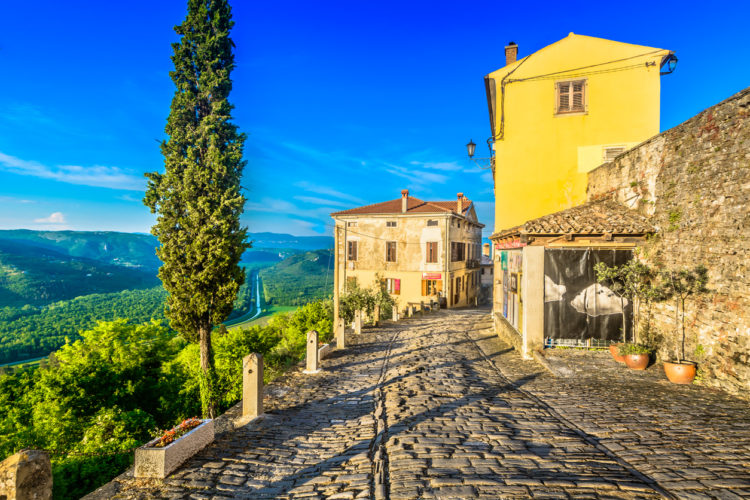

This heart-shaped peninsula was the birthplace of modern Croatian tourism, and it’s easy to see why. Its history has bestowed it with Italian sophistication, most obviously seen in pastel-painted coastal towns, like romantic Rovinj. But, tear yourself away from the Istrian coast, through the vineyards, olive groves, and dense forests, and you will discover brilliantly preserved medieval towns and villages, where cobbled streets reveal quaint galleries, sweet squares and sea-views.
These small rural communities supply the coast’s fancy restaurants with some of the world’s finest ingredients. From the wild asparagus and rich white truffles which adorn their menus, to the unmistakable smell of roasting chestnuts which waft around the region in winter. It’s Istria’s heady mix of world-class gastronomy, rich history and superb scenery which make it one of our favourite destinations for year-round adventures.
Like a lot of destinations in Europe, the best time to visit is just outside of the peak summer months. Aim to visit Istria in June or September – where the average temperature is between 24° and 26°, the evenings are balmy, and the tourists are back at home (or at least, a lot of them are). But if you don’t mind the tourists, you enjoy lying by the pool soaking up the sun – and let’s be real here, the only time the kids can go on holiday is in those busy summer months – then you’ve got to visit between July and August. It’s 29° on average, and it’s still just as beautiful.


Idyllic landscapes of Motovun old town
In summer, British Airways, easyJet and Ryanair (plus a handful of other airlines) run regular flights between the UK and Pula Airport. If you haven’t arranged car hire from Pula, you can catch a taxi or bus to the main coastal resorts.
Trieste and Venice are also relatively close, and make good alternative airports out of season, with buses connecting them to Pula and some Istrian resorts. It’s also possible to travel from Venice to Istria’s main coastal resorts by ferry from April – October.
The crumbling ruins of the Roman Coliseum in Pula
Istria’s history is complex and bloody. History buffs will appreciate the Roman legacy, particularly visible in Pula, one of the best towns in Istria for sightseeing. The city’s impressively preserved 1st-Century amphitheatre, The Arena, is a must-see. The main square and the port also feature Roman temples and glorious arches. Many of the region’s smaller towns house splendid churches; Poreč’s 6th-Century basilica is our favourite, showcasing Byzantine architecture and a mosaic-covered apse.
Inland, Istria is Croatia’s pantry, and visitors are spoilt for choice when it comes to authentic Istrian food, with forests hiding highly sought-after white truffles, olive groves carpeting its slopes and rural farms producing superb cured meats. Undulating hills, a moderate and balmy climate have also helped the region scoop plenty of international wine awards in recent years. Our Istrian wineries and food guide reveal some of the best vineyards Istria has to offer, as well as alternative spots to sample the best Istrian wines.
Locals love a festival, celebrating everything from food and wine to art, film and dance. And as summer descends on Istria, so do the world’s best DJs. Pula’s 19th-Century defence fortress, Fort Punta Christo, is the top venue for big gigs and music events, but it’s local food festivals which dominate Istria’s calendar – honouring everything from wild asparagus and olive oil to chestnuts and those famous Istrian truffles.
Many of the best Istrian beaches are actually pebbly coves or rocky bathing areas. The lack of sand is a big bonus for snorkellers, providing crystal clear waters. However, if you’re after a sandy beach, Istria has a handful to choose from – one of the most popular is well-equipped Bijeca, near family-friendly Medulin.
One of the many azure bays on Istria’s coastline
The pastel-hued streets of Rovinj
At Oliver’s Travels, we’re always looking for new ways to take luxury villa stays to… Read More
Step into the past and embrace the extraordinary with our Heritage Collection – a handpicked… Read More
Welcome to the epitome of luxury and cinematic glamour! Found on the sun-kissed French Riviera,… Read More
We don't usually associate Britain's southeast shores with beautiful beaches – but if you know… Read More
The Costa Brava is beautiful, brilliant and beguiling all at once, but it's very often forgotten… Read More
Gorgeous beaches and hidden coves, picturesque towns and stunning scenery - Croatia has everything you could possibly… Read More